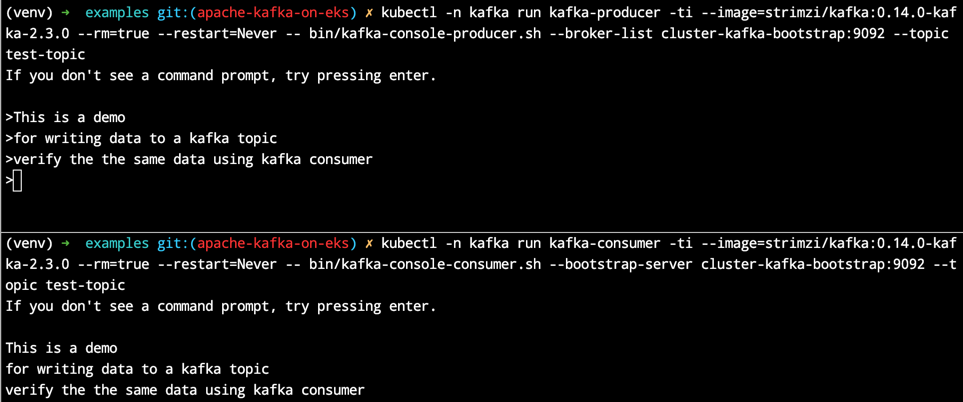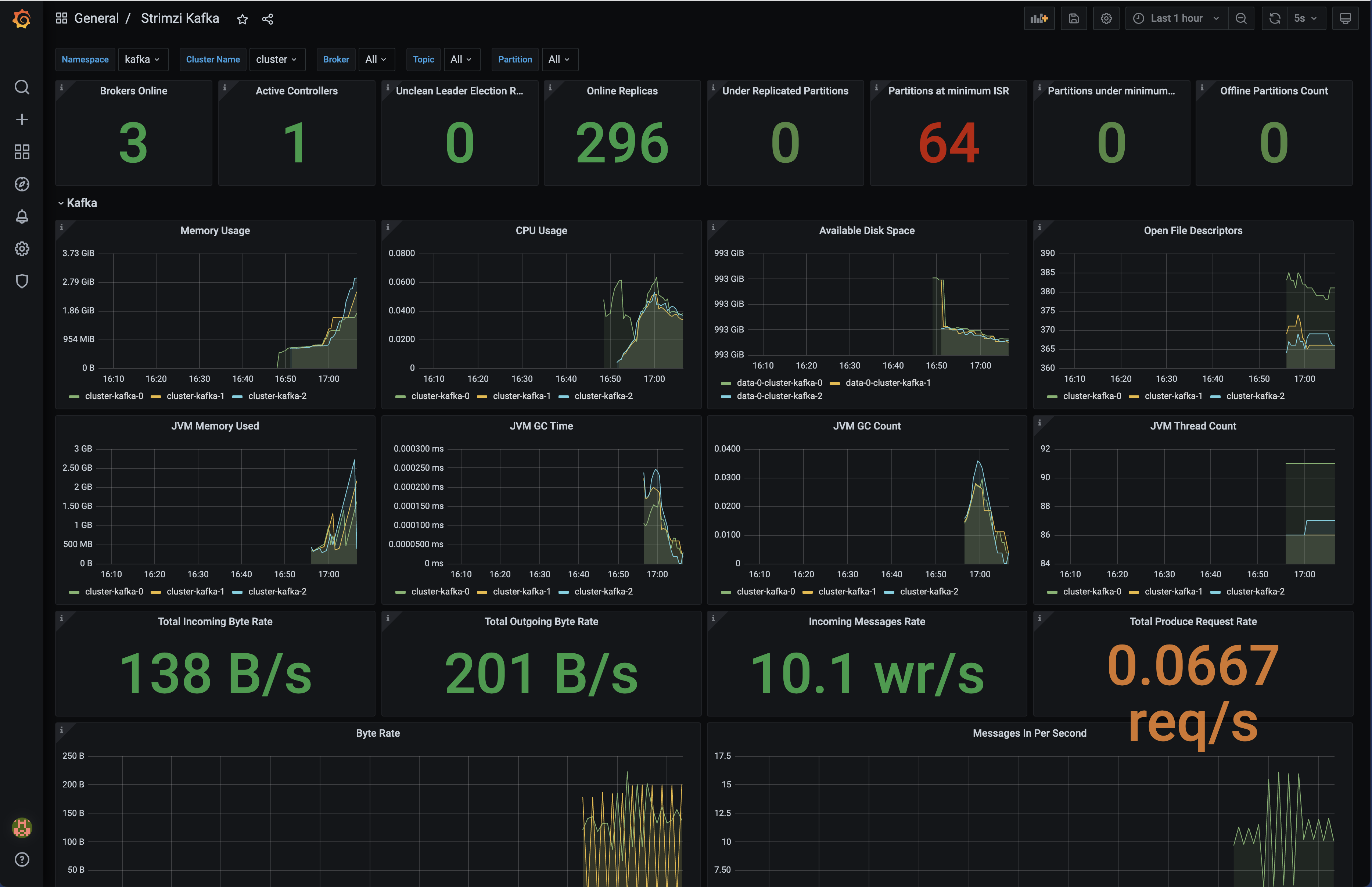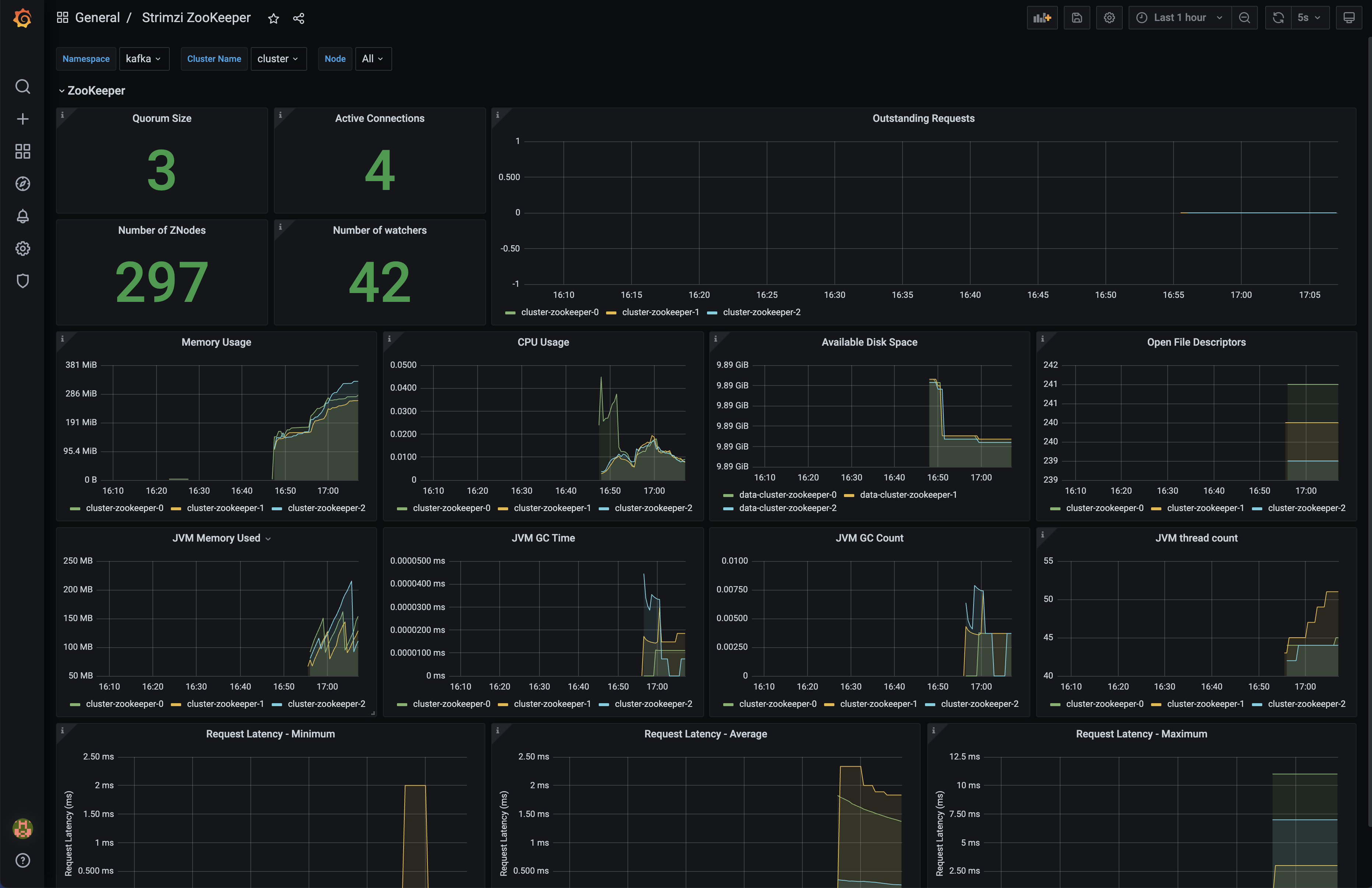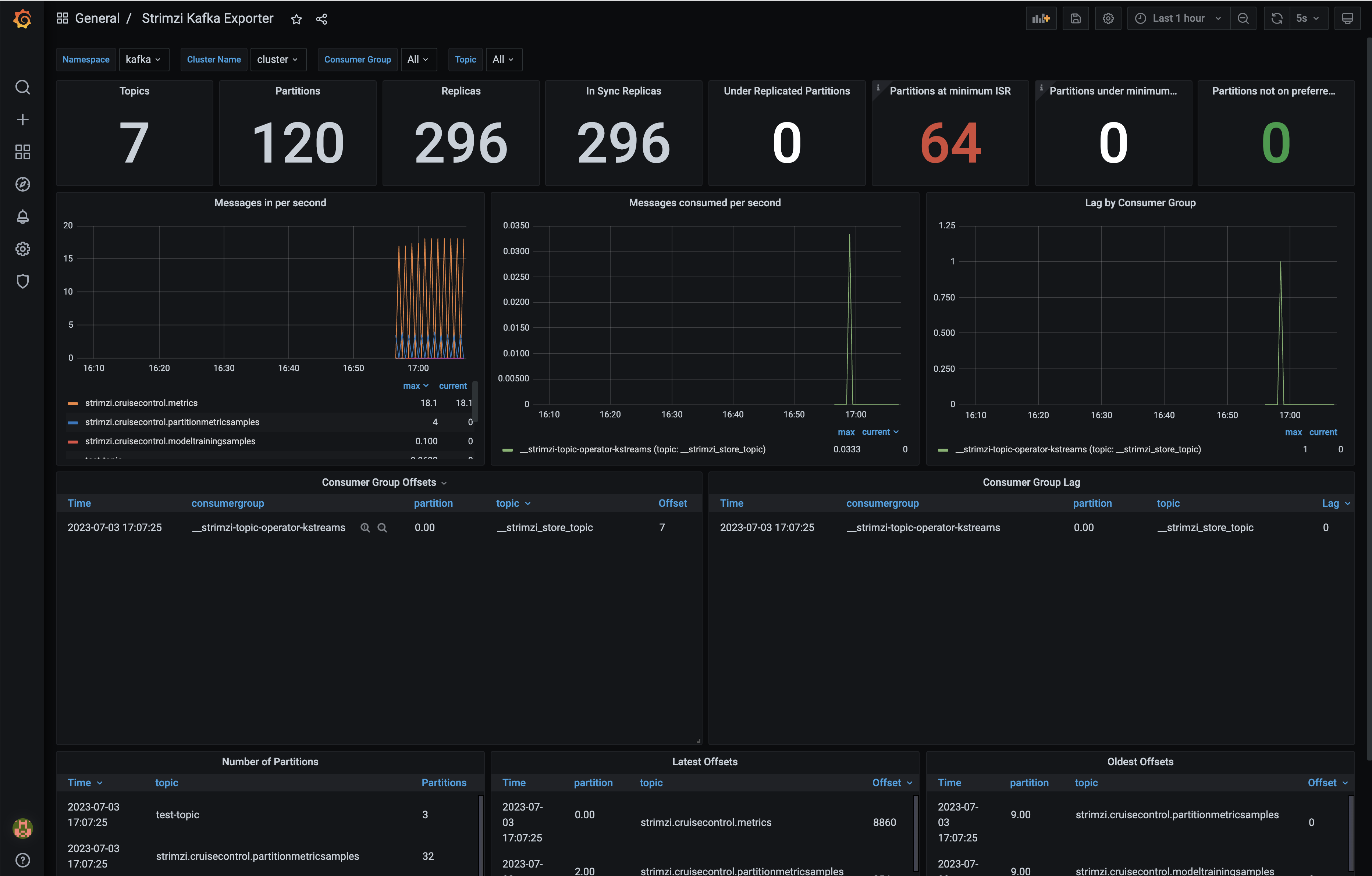Apache Kafka
Apache Kafka is an open-source distributed event streaming platform used by thousands of companies for high-performance data pipelines, streaming analytics, data integration, and mission-critical applications.
Strimzi for Apache Kafka
Strimzi provides a way to run an Apache Kafka cluster on Kubernetes in various deployment configurations. Strimzi combines security and simple configuration to deploy and manage Kafka on Kubernetes using kubectl and/or GitOps based on the Operator Pattern.
Architecture
Architecture diagram work in progress
Managed Alternatives
Amazon Managed Streaming for Apache Kafka (MSK)
Amazon Managed Streaming for Apache Kafka (Amazon MSK) is a fully managed service that enables you to build and run applications that use Apache Kafka to process streaming data. Amazon MSK provides the control-plane operations, such as those for creating, updating, and deleting clusters. It lets you use Apache Kafka data-plane operations, such as those for producing and consuming data. It runs open-source versions of Apache Kafka. This means existing applications, tooling, and plugins from partners and the Apache Kafka community are supported. You can use Amazon MSK to create clusters that use any of the Apache Kafka versions listed under Supported Apache Kafka versions. Amazon MSK offers cluster-based or serverless deployment types.
Amazon Kinesis Data Streams (KDS)
Amazon Kinesis Data Streams (KDS) allows users to collect and process large streams of data records in real time. You can create data-processing applications, known as Kinesis Data Streams applications. A typical Kinesis Data Streams application reads data from a data stream as data records. You can send the processed records to dashboards, use them to generate alerts, dynamically change pricing and advertising strategies, or send data to a variety of other AWS services. Kinesis Data Streams support your choice of stream processing framework including Kinesis Client Library (KCL), Apache Flink, and Apache Spark Streaming. It is serverless, and scales automatically.
Storage considerations when self-managing Kafka
The most common resource bottlenecks for Kafka clusters are network throughput, storage throughput, and network throughput between brokers and the storage backend for brokers using network attached storage such as Amazon Elastic Block Store (EBS).
Advantages to using EBS as persistent storage backend
- Improved flexibility and faster recovery: Fault tolerance is commonly achieved via broker (server) replication within the cluster and/or maintaining cross-AZ or region replicas. Since the lifecycle of EBS volumes is independent of Kafka brokers, if a broker fails and needs to be replaced, the EBS volume attached to the failed broker can be reattached to a replacement broker. Most of the replicated data for the replacement broker is already available in the EBS volume, and does not need to be copied over the network from another broker. This avoids most of the replication traffic required to bring the replacement broker up to speed with current operations.
- Just in time scale up: The characteristics of EBS volumes can be modified while they’re in use. Broker storage can be automatically scaled over time rather than provisioning storage for peak or adding additional brokers.
- Optimized for frequently-accessed-throughput-intensive workloads: Volume types such as st1 can be a good fit since these volumes are offered at a relatively low cost, support a large 1 MiB I/O block size, max IOPS of 500/volume, and includes the ability to burst up to 250 MB/s per TB, with a baseline throughput of 40 MB/s per TB, and a maximum throughput of 500 MB/s per volume.
What EBS volumes should I use when self-managing Kafka on AWS?
- General purpose SSD volume gp3 with a balanced price and performance are widely used, and you can independently provision storage (up to 16TiB), IOPS (up to 16,000) and throughput (up to 1,000MiB/s)
- st1 is a low-cost HDD option for frequently accessed and throughput intensive workloads with up to 500 IOPS and 500 MiB/s
- For critical applications such as Zookeeper, provisioned IOPS volumes (io2 Block Express, io2) provide higher durability
Deploying the Solution
In this example, you will provision the following resources to run Kafka Cluster on EKS.
This example deploys an EKS Cluster with Kafka into a new VPC.
- Creates a new sample VPC, 3 Private Subnets and 3 Public Subnets.
- Creates Internet gateway for Public Subnets and NAT Gateway for Private Subnets.
- Creates EKS Cluster Control plane with public endpoint (for demo reasons only) with two managed node groups.
- Deploys Metrics server, Cluster Autoscaler, self-managed ebs-csi-driver, Strimzi Kafka Operator, Grafana Operator.
- Strimzi Kafka Operator is a Kubernetes Operator for Apache Kafka deployed to
strimzi-kafka-operatornamespace. The operator by default watches and handleskafkain all namespaces.
Prerequisites
Ensure that you have installed the following tools on your machine.
Deploy
Clone the repository
git clone https://github.com/awslabs/data-on-eks.git
Navigate into one of the example directories and run terraform init
cd data-on-eks/streaming/kafka
terraform init
Run Terraform plan to verify the resources created by this execution.
export AWS_REGION="us-west-2" # Select your own region
terraform plan -var="region=$AWS_REGION"
Deploy the pattern
terraform apply -var="region=$AWS_REGION"
Enter yes to apply.
This deployment may take between 20 to 30mins.
Verify the deployment
Create kube config
Create kube config file.
aws eks --region $AWS_REGION update-kubeconfig --name kafka-on-eks
Get nodes
Check if the deployment has created 6 nodes. 3 nodes for Core Node group and 3 for Kafka brokers across 3 AZs.
kubectl get nodes
Output
NAME STATUS ROLES AGE VERSION
ip-10-0-10-36.us-west-2.compute.internal Ready <none> 5h28m v1.24.7-eks-fb459a0
ip-10-0-10-47.us-west-2.compute.internal Ready <none> 5h20m v1.24.7-eks-fb459a0
ip-10-0-11-218.us-west-2.compute.internal Ready <none> 5h20m v1.24.7-eks-fb459a0
ip-10-0-11-223.us-west-2.compute.internal Ready <none> 5h20m v1.24.7-eks-fb459a0
ip-10-0-12-202.us-west-2.compute.internal Ready <none> 5h20m v1.24.7-eks-fb459a0
ip-10-0-12-50.us-west-2.compute.internal Ready <none> 5h20m v1.24.7-eks-fb459a0
Verify Kafka Brokers and Zookeeper
Verify the Kafka Broker and Zookeeper pods and the status created by the Strimzi Operator.
kubectl get strimzipodsets.core.strimzi.io -n kafka
Output
NAME PODS READY PODS CURRENT PODS AGE cluster-kafka 3 3 3 4h35m cluster-zookeeper 3 3 3 4h36m
kubectl get kafka.kafka.strimzi.io -n kafka
Output
NAME DESIRED KAFKA REPLICAS DESIRED ZK REPLICAS READY WARNINGS cluster 3 3 True
kubectl get kafkatopic.kafka.strimzi.io -n kafka
Output
NAME CLUSTER PARTITIONS REPLICATION FACTOR READY consumer-offsets---84e7a678d08f4bd226872e5cdd4eb527fadc1c6a cluster 50 3 True strimzi-store-topic---effb8e3e057afce1ecf67c3f5d8e4e3ff177fc55 cluster 1 3 True strimzi-topic-operator-kstreams-topic-store-changelog---b75e702040b99be8a9263134de3507fc0cc4017b cluster 1 3 True strimzi.cruisecontrol.metrics cluster 1 3 True strimzi.cruisecontrol.modeltrainingsamples cluster 32 2 True strimzi.cruisecontrol.partitionmetricsamples cluster 32 2 True
Verify the running Kafka pods
kubectl get pods -n kafka
Output
NAME READY STATUS RESTARTS AGE cluster-cruise-control-79f6457f8d-sm8c2 1/1 Running 0 4h40m cluster-entity-operator-5594c965ff-t9nl4 3/3 Running 0 4h40m cluster-kafka-0 1/1 Running 0 4h41m cluster-kafka-1 1/1 Running 0 4h41m cluster-kafka-2 1/1 Running 0 4h41m cluster-kafka-exporter-9dbfdff54-wx8vq 1/1 Running 0 4h39m cluster-zookeeper-0 1/1 Running 0 4h42m cluster-zookeeper-1 1/1 Running 0 4h42m cluster-zookeeper-2 1/1 Running 0 4h42m
Create Kafka Topic and run Sample test
We will create one kafka topic and run sample producer script to produce new messages to the kafka topic. We can then verify the data in the topic using sample consumer script.
Create a kafka Topic
Run this command to create a new topic called test-topic under kafka namespace
cd streaming/kafka/examples/
kubectl apply -f kafka-topics.yaml
Verify the status of the test-topic topic.
kubectl exec -it cluster-kafka-0 -c kafka -n kafka -- /bin/bash -c "/opt/kafka/bin/kafka-topics.sh --list --bootstrap-server localhost:9092"
Output
__consumer_offsets __strimzi-topic-operator-kstreams-topic-store-changelog __strimzi_store_topic strimzi.cruisecontrol.metrics strimzi.cruisecontrol.modeltrainingsamples strimzi.cruisecontrol.partitionmetricsamples test-topic
Execute sample Kafka Producer
Open two terminals one for Kafka producer and one for Kafka Consumer.
Execute the following command and press enter twice until you see the > prompt.
Start typing some random content. This data will be written to the test-topic.
kubectl -n kafka run kafka-producer -ti --image=strimzi/kafka:0.14.0-kafka-2.3.0 --rm=true --restart=Never -- bin/kafka-console-producer.sh --broker-list cluster-kafka-bootstrap:9092 --topic test-topic
Execute sample Kafka Consumer
Now, you can verify the data written to test-topic by running Kafka consumer pod in another terminal
kubectl -n kafka run kafka-consumer -ti --image=strimzi/kafka:0.14.0-kafka-2.3.0 --rm=true --restart=Never -- bin/kafka-console-consumer.sh --bootstrap-server cluster-kafka-bootstrap:9092 --topic test-topic
Kafka Producer and Consumer output

Grafana Dashboard for Kafka
Login to Grafana
Login to Grafana dashboard by running the following command.
kubectl port-forward svc/kube-prometheus-stack-grafana 8080:80 -n kube-prometheus-stack
Open browser with local Grafana Web UI
Enter username as admin and password can be extracted from AWS Secrets Manager with the below command.
aws secretsmanager get-secret-value \
--secret-id kafka-on-eks-grafana --region $AWS_REGION --query "SecretString" --output text
Open Strimzi Kafka Dashboard
The below are builtin Kafka dashboards which created during the deployment.

Open Strimzi Zookeeper Dashboard

Open Strimzi Kafka Exporter
You can verify the test-topic with three partitions below.

Cleanup
To clean up your environment, destroy the Terraform modules in reverse order with --target option to avoid destroy failures.
Destroy the Kubernetes Add-ons, EKS cluster with Node groups and VPC
terraform destroy -target="module.eks_blueprints_kubernetes_addons" -auto-approve
terraform destroy -target="module.eks_blueprints" -auto-approve
terraform destroy -target="module.vpc" -auto-approve
Finally, destroy any additional resources that are not in the above modules
terraform destroy -auto-approve
To avoid unwanted charges to your AWS account, delete all the AWS resources created during this deployment
ex. Delete kafka-on-eks EBS volumes